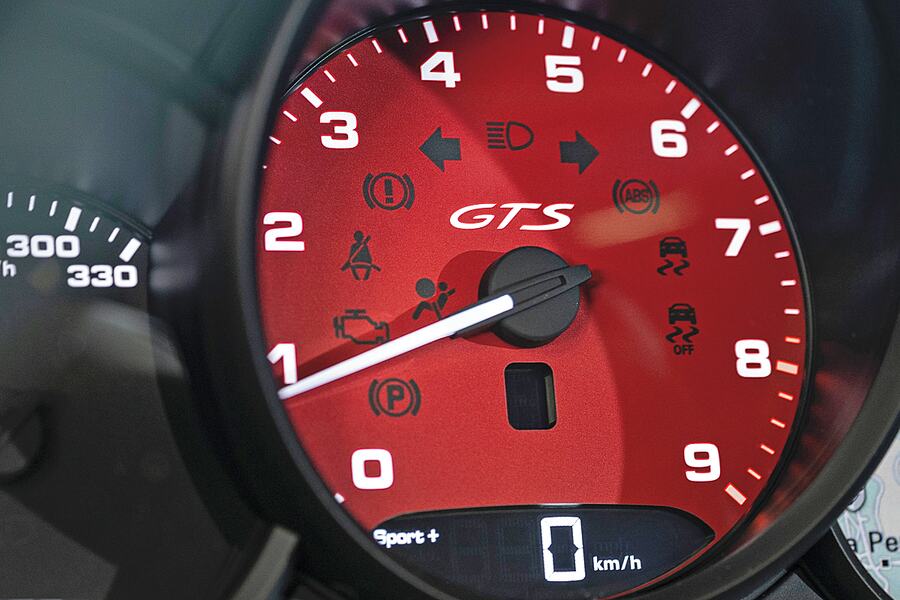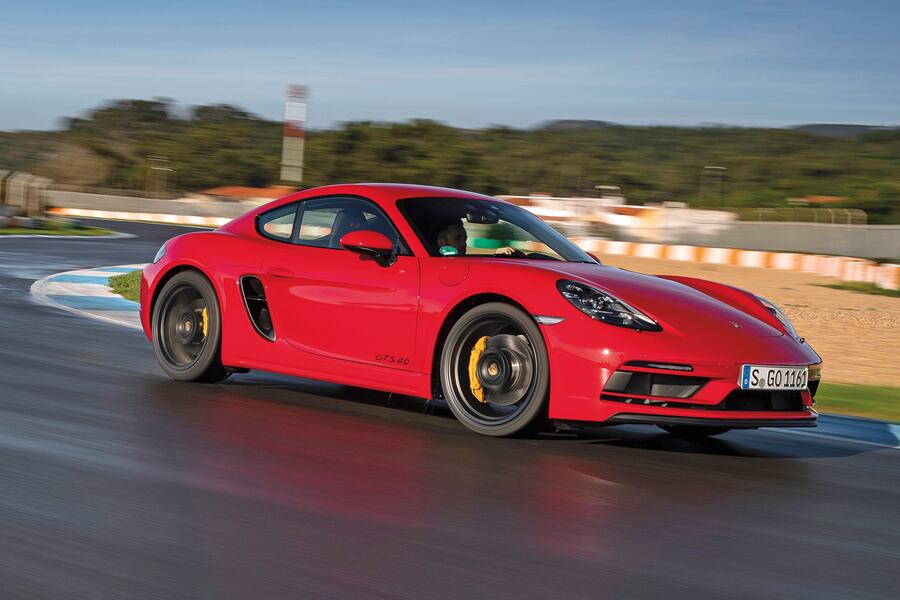You can’t blame us for wanting a little more seat time with a manually-shifted 718 Cayman GTS 4.0. With big changes on the horizon for the svelte coupe as well as the Boxster, its droptop counterpart, the urge to savor the moment has never been stronger. Originally envisioned as more accessible entry points into the brand, the two models have matured significantly over recent years, yet the fundamentals have remained intact.
While the 911 remains a unique and utterly compelling driving experience, the march of progress has altered its mission to a tangible degree. With the introduction of the refreshed 992.2-generation 911 for 2025, Porsche’s rear-engined machine continues to evolve into a more sophisticated and capable performer. But as technology takes on a larger and larger role in its advancement, the 718 is starting to feel like a throwback in all of the right ways. Today, we look at 10 ways the flat-six-powered 718 coupe outdoes its legendary sibling.
1) The 718 is the right size for a sports car.
It’s no secret that the 911’s proportions have increased over the decades, and the introduction of the 992 back in 2018 didn’t buck that trend. This growth has allowed the 911’s skillset to expand, but that expansion has also increasingly shifted its priorities away from outright sporting intent in favor of broader grand touring appeal. Versatility certainly has its merits, but for those seeking a dyed-in-the-wool sports car, the 718 is more squarely aimed at the task.
While the dimensions of the 911 have risen substantially over time, the Cayman and Boxster have only seen marginal change since the debut of the 986 nearly 30 years ago. The 718 is less than an inch and a half longer than the original Boxster, and both its height and width remain within fractions of an inch of that car. That means there’s never any ambiguity about where you’re placing the 718 on the road, whether that involves trail braking your way through a fast corner or simply squeezing into a tight parking spot. The 718 is still a sports car that offers everything you need and nothing you don’t.
2) You don’t have to go to Porsche’s GT department to get a naturally aspirated flat-six.

The proliferation of turbocharging throughout the range has made the 911 a quicker and more efficient car. But it has also come with compromises, like a less emotive soundtrack and power delivery that isn’t as linear as its naturally aspirated forebearers. You can still get your kicks free of forced induction with the latest GT3 and GT3 Touring, of course, but the bar of entry for those models now starts well north of $200,000.
And much like the Cayman GT4 and GT4 RS, their track-focused tuning isn’t for everyone. The 718 GTS 4.0 is an outlier in that regard, offering a pitch-perfect balance between everyday comfort and performance prowess with a howling 394-hp naturally aspirated 4.0-liter flat-six engine leading the charge to 7,800 rpm. It’s a combination that you simply cannot replicate within the current 911 lineup.
3) The 718 still has a “key.”
With the introduction of the 992.2-gen 911 for 2025, Porsche did away with the 911’s distinctive twist-to-start faux-key in favor of a conventional start/stop button on models like the Carrera, Carrera T, and Carrera GTS. As Porsche explained it, the change was made to bring a sense of consistency and familiarity to the automaker’s latest lineup, as the Porsche Driver Experience cockpit layout (and the starter button in question) had previously been introduced in updated versions of the Panamera and Cayenne.
This might sound like a trivial change to some, but it rightfully caused a stir among the 911 faithful, and Porsche wisely chose to retain this tactile heritage callback on the 992.2 GT3 and GT3 Touring. But you don’t need to look to the GT department to get a twist-to-start key in a 718—it’s still standard equipment throughout the lineup.
4) The 718 still has an analog tachometer.

Another 992.2 update that saw its fair share of controversy was the switch from a gauge cluster with a center-mounted analog tachometer flanked by digital displays to a fully digital 12.6-inch curved display. The new display earns its keep by offering greater customizability. The 2025 GT3, for example, has a setting that positions its 9,000 rpm redline at 12 o’clock on the digital tachometer to make it easier to judge when to upshift at a glance.
But watching the needle sweep through the revs on the big Carmine Red dial in our 718 test car served as a reminder that replacing time-honored design elements with more advanced solutions can sometimes take away as much as it adds.
5) The engine is in the right place.
Thanks to nearly eight decades of rear-engine development, Porsche has honed the 911 into one of the most rewarding, capable, and inimitable sports cars in automotive history. But that doesn’t change the fact that roughly 60 percent of its weight is situated at the back of the car.
The Cayman and Boxster, meanwhile, have always offered better weight distribution and more traditional handling characteristics due to their mid-engine layout. Although the 718 Cayman GTS 4.0 can’t replicate the singular experience of a 911 driven in anger, it’s easier to wrangle near the limit, and it never throws any curveballs when the mass shifts from one end of the car to the other.
6) The 718 is still light.

Porsche seems to be one of the few automakers that is still willing to acknowledge that weight is the enemy of performance, but the 992.2 has gained a few pounds nonetheless. Although the additional mass seems pretty minor on paper—roughly a hundred pounds or so over the 992.1, depending on the which trim you’re comparing—it’s important to note that rear seats are now a no-cost option, rather than standard equipment, on models like the Carrera and Carrera S.
This allows for a rosier official figure while ignoring the reality that the curb weights of these models are no longer directly comparable to their 992.1 predecessors. So while a 2025 992.2 Carrera officially weighs 3,342 pounds, the cars that have been put on the scale by various media outlets are closer to 3,500 in as-tested specifications with the rear seats added back in.
The Cayman GTS 4.0, meanwhile, officially weighs 3,175 lbs, and even well-optioned test cars have come in within a few pounds of that figure when independently measured. That means the GTS 4.0 is not only lighter than the Carrera T (a lightweight special which carries an official figure of 3,316 lbs), it’s also lighter than the 992.2 911 GT3, the latter of which comes in at 3,243 lbs when equipped with a six-speed manual transmission.
7) More storage space.
Another benefit of the 718’s mid-engine layout is that there’s room for cargo in the back of the car in addition to its frunk space, while the frunk is the only area that’s actually earmarked for storage in a 911. Even if you count the area behind the 911’s front seats as a cargo space (despite the lack of a rear hatch), a 992.2 coupe still can’t match the 718 Cayman’s 14.7 cubic feet of total capacity.
This talking point might not impress folks at your next track day, but it’s a good one to have in your back pocket when you’re desperately trying to convince your spouse that this is a practical purchase.

8) Better cup holders.
Yes, it’s a minor detail, and the rickety cup holders in the Boxster and Cayman have long been a source of consternation for owners. But they’re still superior to the design used in the 992.
Unlike the 991-generation 911 which, like the 718, was equipped with cup holders that sprung out and unfolded from a concealed area above the glove box, the 992 has a spot on the center console that’s allocated to serve as either a key holder or a cup holder. Not only does this mean your passenger is out of luck if both of you have drinks, but the placement of the cup holder puts the drink directly in the path of the driver’s right elbow in a manually-shifted 911.
Flimsy or not, at least you don’t have to skip the even-numbered gears in a 718 if you’ve got a coffee along for the ride.
9) More manual models.
A manual transmission was either optional or standard equipment for every mainline 992.1-gen 911 model aside from the base Carrera, Turbo, Turbo S, and GT3 RS. But for 2025, manual availability has been pared down to just three iterations of the 992.2—the Carrera T, the GT3, and the GT3 Touring. Citing the continued decline of manual transmission take rates across the auto industry, Porsche has said that offering a manual in these particular models allowed them to bring three pedals to the widest scope of customers, but even at the more affordable end of that spectrum, a base price of nearly $140,000 still excludes a lot of folks from the conversation.

By contrast, every 718 Cayman and Boxster, aside from the GT4 RS and Spyder RS, features a manual transmission as-standard; the precise and perfectly weighted six-speed found in our GTS 4.0 tester. We still don’t know why Porsche won’t allow us to control the auto blip feature independently of the drive mode and Porsche Stability Management settings, though.
10) It’s (much) more accessible.
The 911 has always commanded a premium over the Boxster and Cayman, but right now the gulf seems especially wide. Even with over $20,000 worth of options on board, our Cayman GTS 4.0 tester rang up a grand total of $122,135 with the destination fee.
That’s not cheap by any stretch of the imagination. Still, it’s worth noting that the difference in price between a ground-floor 2025 992.2 Carrera and this well-appointed Cayman with a near-400 hp naturally aspirated flat-six engine, a six-speed manual transmission, and a raft of performance-minded upgrades is about the cost of a drive-thru dinner for two.
The good news is that you can’t really go wrong either way—the 992.2 Carrera is a fantastic sports car in its own right, regardless of trim level. But as we grapple with the fact that the Boxster and Cayman’s internal combustion era is drawing to a close, we can’t help but notice that the 718 has become the last refuge for many long-standing Porsche traditions.
Beyond the howl of its unrestricted flat-six or the satisfaction that comes from rowing through its gearset, the 718 Cayman GTS 4.0 is a bastion of simplicity, and about as analog as mainstream performance cars get in 2025. There are drive modes, but you hardly need them because you can count the number of settings options on one hand, and there are toggle buttons on the center console for almost all of them anyway
There’s no 12-stage stability control program because a chassis this well-balanced does most of the work for you. And there’s no need for quadruple-digit horsepower because the curb weight figure doesn’t start with a five. The 718 may be stuck in the past, but it seems to be aging more gracefully by the day.







